Middle Earth Strategy Battle
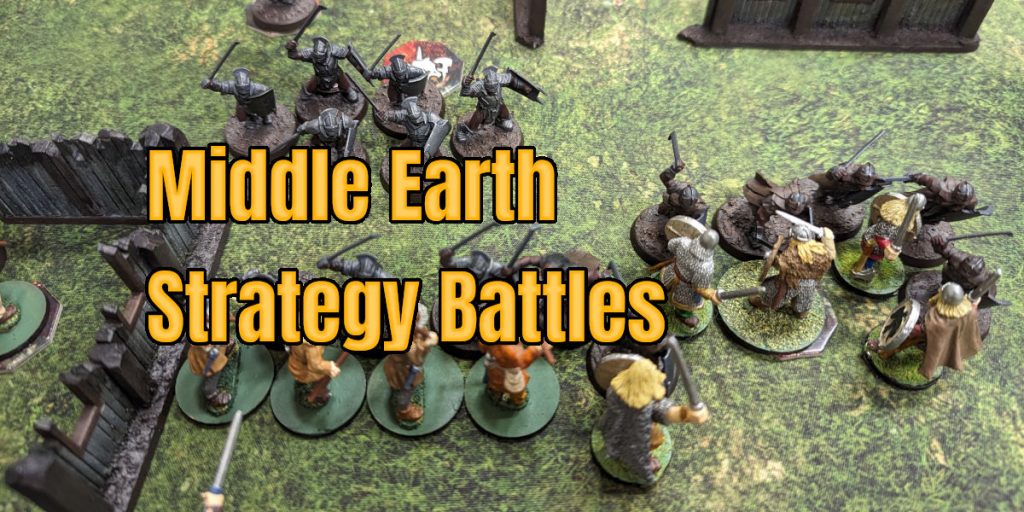
This week’s wargaming was a chance to play the Middle Earth Strategy Battle Game. I haven’t played this before, though I’ve seen a few small games run at the club. I got a chance to use some of my Vikings miniatures in place of Rohan warriors. None of my Rohan had their horses with them though.
I had two groups of warriors, each had a single hero, 4 spearmen, 4 bowmen and 4 swordsmen. This gave me a total of 26 figures. I was up against two groups of Uruk-hai.

Unlike most other games I’ve played, the Middle Earth doesn’t really organise forces into units. Though I had a group of spearmen, they weren’t used as a ‘group’, but as four individual figures. Each figure moves, fights and dies separately.
The scenario was to grab five objectives from the ruins of a village. The objectives represented the corpses of humans that needed to be taken for decent burial (or eaten for lunch for the Uruk-hai). So all the Rohan needed to do was move forward quickly, grab the objectives and then run back. I had archers and spearmen, which the Uruk-hai didn’t have any of, so I was hoping to be able to use them to pepper the orcs with arrows at range whilst my swordsmen went for the objectives.
The first couple of turns was mostly movement. In turn one, the Uruk-hai used one of their hero’s special abilities to give him and all figures within 6″ an extra 3″ of movement to rush forward. I decided to wait until the second turn to do that.
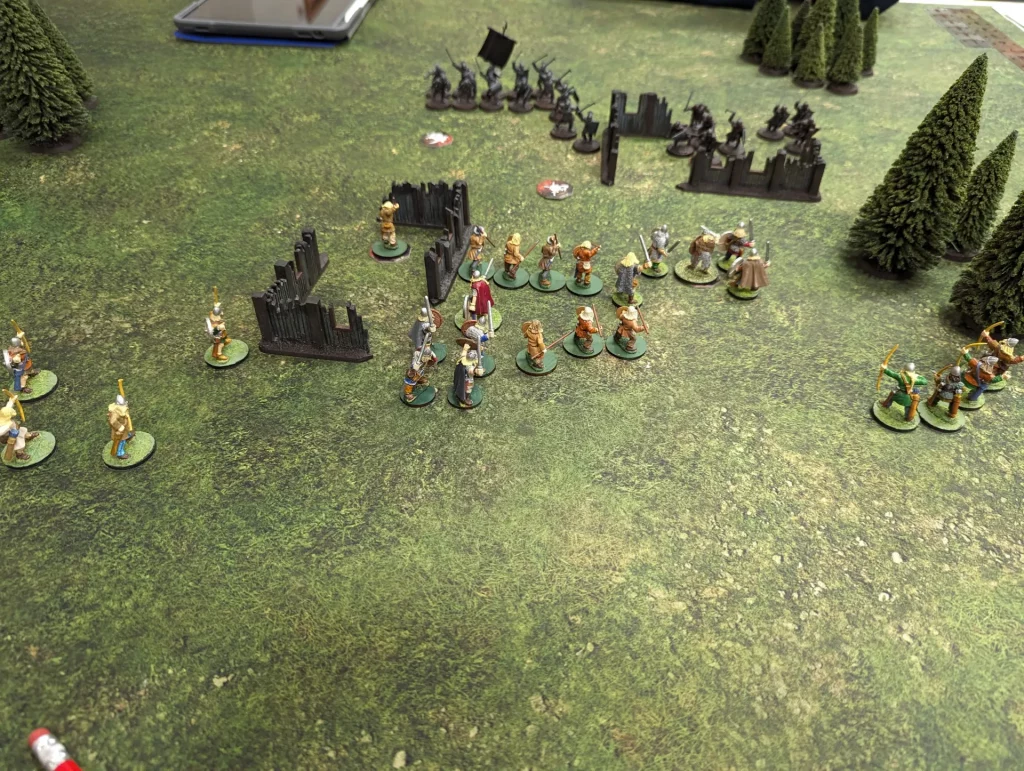
Each turn is split into phases – Priority, Move, Shoot, Fight and End phase. In the priority phase we get to decide which side has priority (i.e., goes first). This is always the ‘good’ side on the first turn, after that we dice for it. There’s a number of things which are based on ‘good’ v ‘evil’, which forces assumptions about the types of battles being fought. I’m not sure how things would resolve if you had two ‘evil’ forces fighting each other, or two ‘good’ forces.
Each of our heroes had two points to spend on special abilities, so we had to conserve them. The orcs got to three objectives markers before me, and I grabbed two, so from the start the advantage was with the orcs. I did get to do a bit of shooting at the end of turn two – but all my arrows either missed or bounced. Arrows are quite weak, needing a 6 to hurt the heavily armoured Uruk-hai.
By turn four we were into melee combat, and this is where the individual nature of the game really becomes apparent. Individual figures face off against each other, it’s not unit against unit.
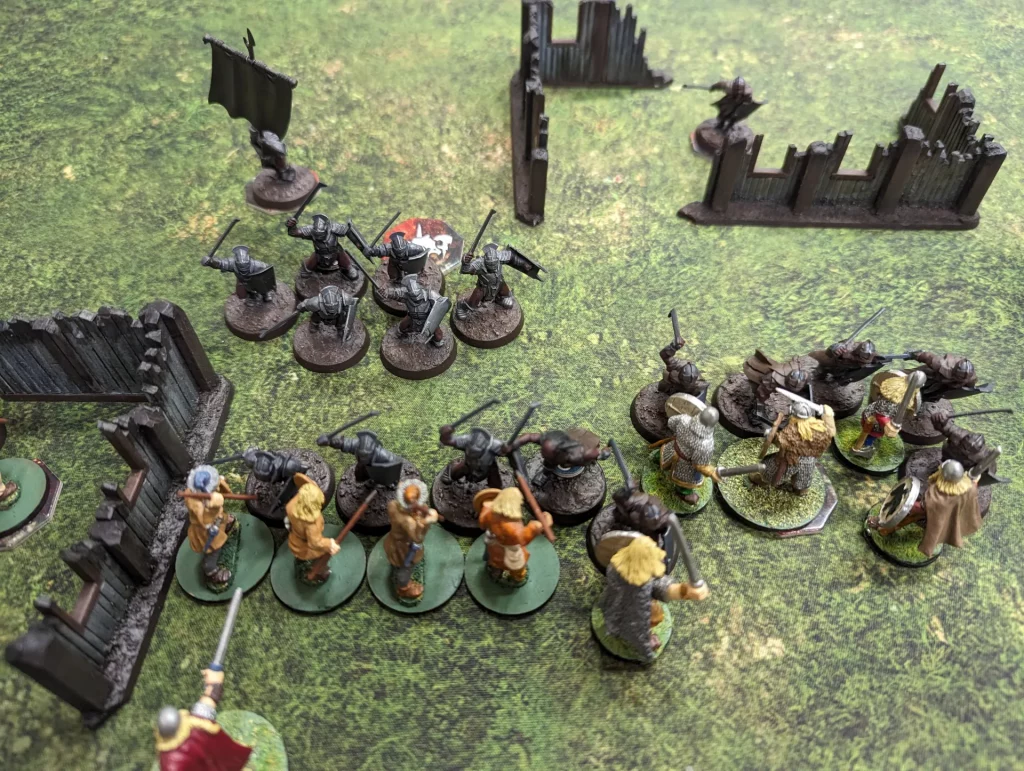
Whomever has priority decides the order in which fights are done. Both combatants (or all, if there are more than two) roll D6, and the side which gets highest ‘wins’. The loser has to fall back 1″, and then the attacker gets a strike to see if they inflict damage and kill their opponent. So combat between two figures can go on for several turns, with each figure being forced back but not necessarily killed.
It’s an interesting dynamic to the game, and quite different to more unit based games such as Saga or Lions Rampant.
A figure with a shield can opt to fight defensively, in which case they get to roll twice the usual number of dice. However, if they win, they don’t get a strike against their opponent. If a figure can’t move back when they are pushed, then the attacker gets double the number of strike dice.
Another difference between ‘good’ and ‘evil’ is that evil characters can shoot over their own troops, but good characters can’t. You need to make an ‘in the way’ check if firing over other figures, walls or similar obstacles. This greatly limited what I could do with my spearmen and archers. The spearmen though could throw their spears as they charged, effectively getting two chances at an attack.
Spear attacks are strong than bows, so several Uruks died from my spearmen, though my archers were still less effective than I wished.
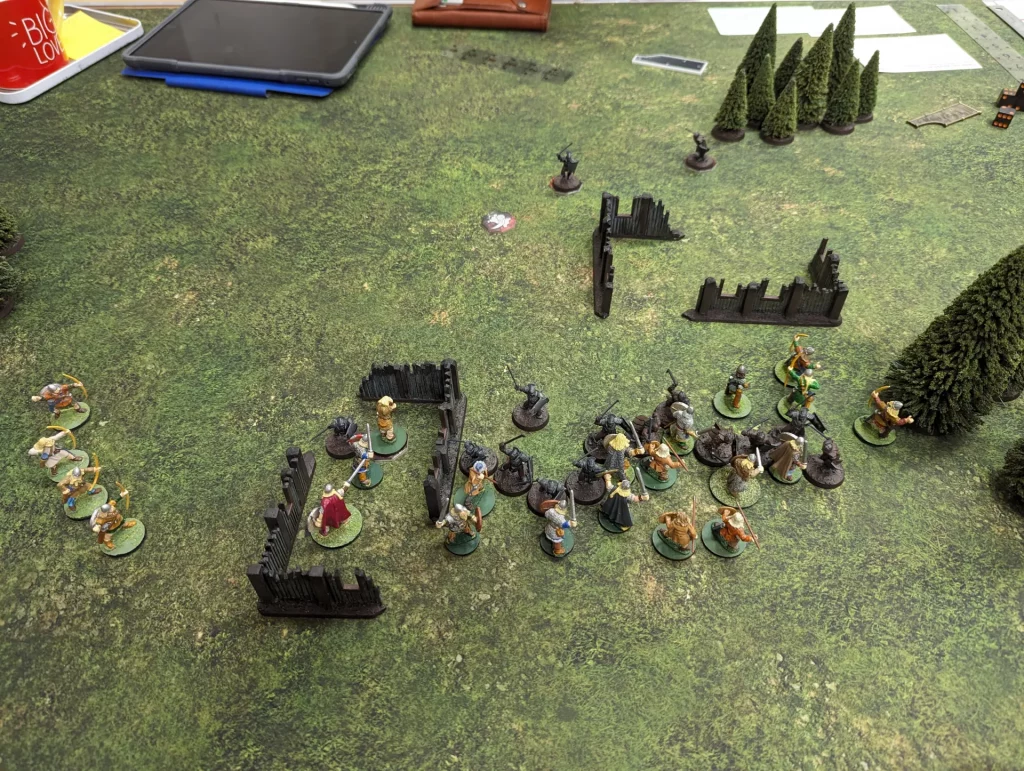
There was a lot of back and forth fighting over the objective in the middle of the village, and it looked like I had control over the objective in the left hand building. However, the Uruk’hai were running away with three of the objective tokens. Eventually my archers took down the Uruk’hai carrying one of the tokens, and after I’d grabbed the left hand one, one of my heroes ran after the dropped token.
Casualties in the middle were high though. There was a lot of back and forth fighting in the central area, which was interesting. You have to win the original dice roll, then win the strike roll to kill someone, so figures were often pushed back but not killed.
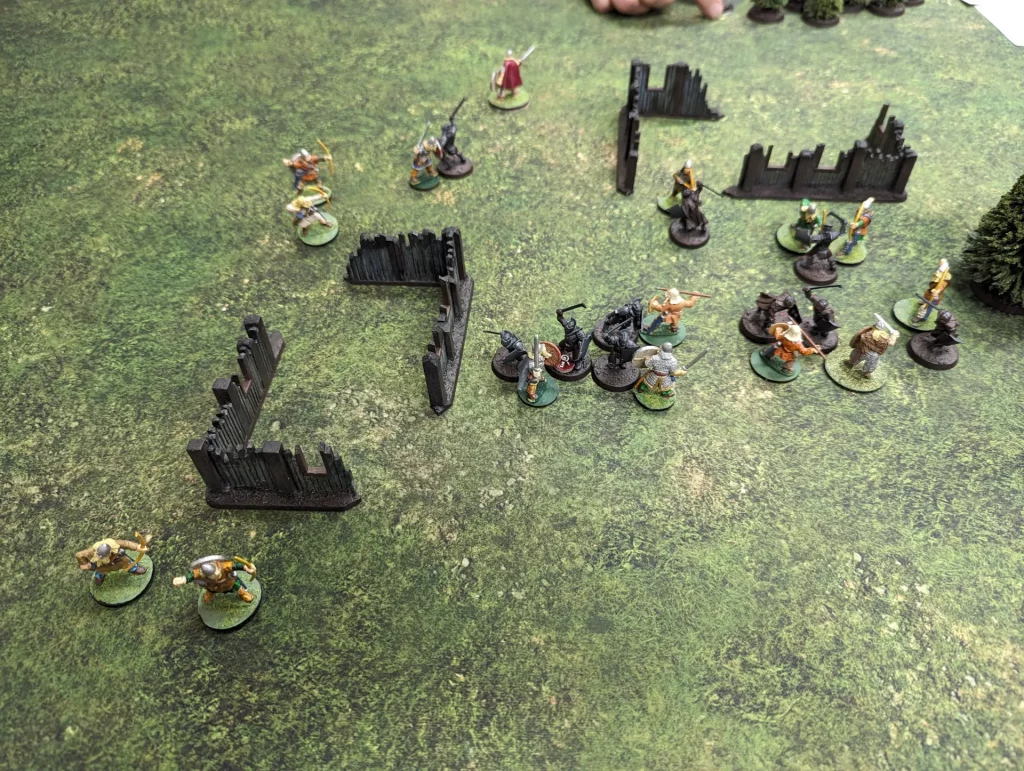
The Uruk’hai definitely had two objectives by this point, and I definitely had one. My hero now had picked up the one dropped by the Uruk-hai, but I had to somehow get it back to my table edge. It seemed unlikely that I’d be able to win the central battle – there were too many Uruk-hai left alive. I might be able to get back a second one though.
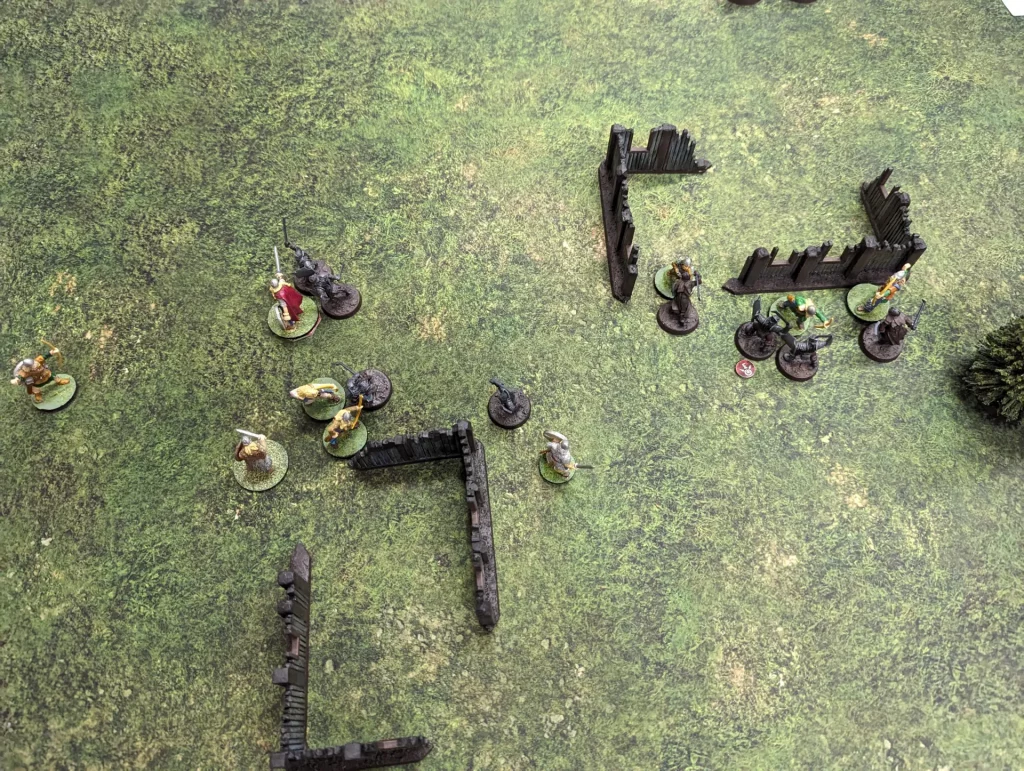
In the end though, it looked like I wouldn’t. The Uruk-hai had won, and the only question left was whether they won with three or four points (out of five). We decided to call it at that point, with my hero still in possession of an objective but with the Uruk-hai harassing.
Middle Earth Strategy Battle is very much a skirmish game for individual figures, rather than a mass battle war game for whole units. However, though you are rolling for each individual figure, the rules are simple enough that it’s actually quite fast. We had 20-30 figures per side, and the game took about as long as a Saga game which could have twice that many figures. However, it didn’t have the equivalent of the Saga Orders phase, so most of the time was rolling dice and moving figures.
It’s considerably slower than Lion Rampant, which also has a higher figure count. So if you want to do mass battles, this probably isn’t it.
For small scale skirmishes though (and 20-30 is probably the most I’d want to do) it worked quite well. I did like the back and forth flow of melee combat, though missile combat seemed a bit on the weak side. That may have simply been because they were up against some heavily armoured Uruk-hai so I was seeing them at their most ineffective.
Admittedly, when I first heard of Middle Earth Strategy Battles, what the name conjured up to me was that it would be a Warhammer-like game with massive armies, designed to fight battles such as the Battle of Pelennor Fields, or the Battle of the Hornburg. This is not that. Instead it seems to be better suited for battles such as Amon Hen, with small groups of figures. So I was originally disappointed because the actual game didn’t match my expectations. Having got over that though, the game does play quite well.
Though I was playing Rohan, we deliberately didn’t have horses. Horses are complicated, because you can fall off your horse and then fight on foot – so you need two miniatures for each figure (one mounted with horse, one on foot). Again, this is a level of complexity you don’t normally get in wargames.
As is often the case, I lost this game. But it was a fun game, and at one point it did feel like I might have a chance at grabbing control of that third objective. I think one problem I had was keeping my archers back from melee, assuming they wouldn’t be any good at it. It turns out they were just as good as the swordsmen except for lacking shields. Something to learn for next time.
Interesting about the archers. In most games you assume you should keep them out of melee.
Thanks Sam – always good to read your updates.
Interesting write-up.
Regarding archers in MESBG, they are just normal soldiers armed with a bow, so they fight like normal soldiers (but the bow costs points so they are a little more valuable). Sometimes there is an option to get them cheaper by paying fewer points for not having a shield or for less good armour.
Yeah, I realised that part way through. I think I was thinking of Saga, where archers are often Levies, and rubbish at melee.